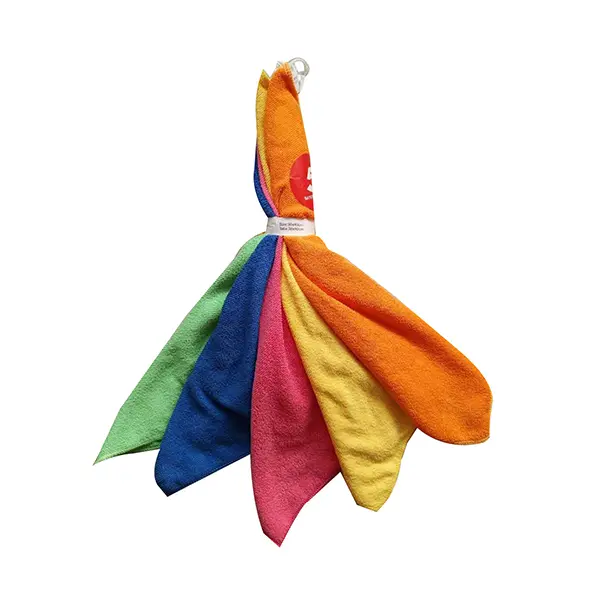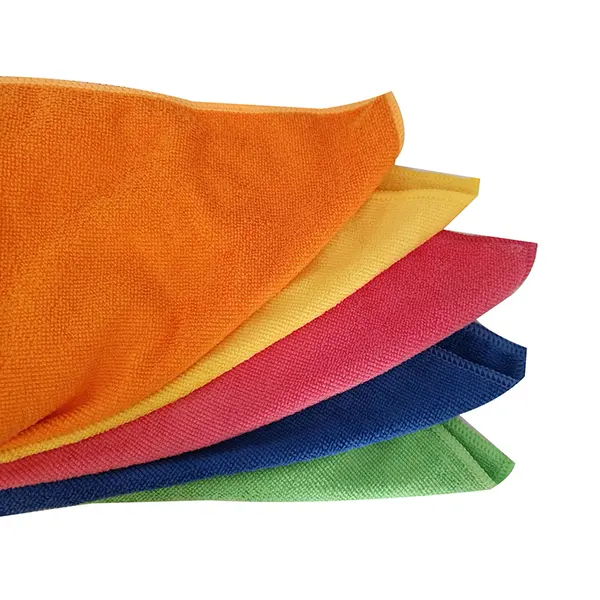Premium Microfiber Kitchen Towels - Ultra Absorbent & Lint-Free
The Evolution of Efficiency: Understanding Microfiber Kitchen Towels in Modern Industries
In an era demanding unparalleled cleanliness and operational efficiency, the humble cleaning cloth has undergone a significant transformation. Traditional cotton towels, while functional, often fall short in industrial and commercial environments where lint-free, streak-free, and highly absorbent performance is critical. This is where microfiber kitchen towels emerge as a superior solution, redefining standards across various sectors. Their unique synthetic composition, typically a blend of polyester and polyamide, allows for microscopic fibers that are far thinner than a human hair. This structural innovation enables an exceptional capacity to pick up and trap dirt, dust, and liquids, making them indispensable for professional cleaning, hospitality, food service, and even precision manufacturing where surface integrity is paramount. The market trend indicates a clear shift towards these advanced textiles, driven by their superior performance, cost-effectiveness over time, and environmental benefits due to reduced chemical usage and extended lifespan. Businesses are increasingly recognizing the long-term value in investing in high-quality microfiber solutions to enhance cleanliness protocols and optimize labor.
The demand for specialized cleaning textiles has propelled the growth of products such as microfibre tea towels, microfiber dish towels, and microfiber dish cloths. These products, while sharing the core microfiber technology, are often tailored for specific applications within kitchen and general cleaning contexts. For instance, tea towels might emphasize quick-drying properties for glassware, while dish cloths prioritize scrubbing power and absorption for countertops. The underlying principle remains the same: a vast surface area created by split fibers that provides superior capillary action. This allows them to absorb many times their weight in liquid and effectively lift and hold particulate matter, preventing redistribution of contaminants. Understanding the specific technical attributes and manufacturing processes behind these products is crucial for procurement managers and facility operators seeking to optimize their cleaning regimens and achieve higher standards of hygiene and efficiency. The integration of advanced textile engineering ensures that each product type meets the rigorous demands of its intended application, offering consistent and reliable performance day after day.
The Craft of Cleanliness: Manufacturing Process of Microfiber Kitchen Towels
The production of high-performance microfiber kitchen towels is a sophisticated process, far removed from simple weaving. It begins with the extrusion of polyester and polyamide polymers into filaments, which are then combined to form bi-component fibers. These fibers are designed with unique cross-sectional shapes, such as pie or orange-slice patterns, which are critical for the subsequent splitting process. This initial extrusion and fiber formation lay the groundwork for the towel's ultimate absorption and cleaning efficacy. The selection of virgin polymer grades is paramount to ensure durability and consistent performance. Following fiber creation, the filaments are texturized and spun into yarn. This yarn is then fed into advanced weaving or knitting machines, depending on the desired towel structure – whether it's a flat weave for polishing or a looped terry for maximum absorption. Precision control over tension and density during this phase ensures the fabric's integrity and long-term resilience.

The most distinctive and crucial step in microfiber manufacturing is the "splitting" process. After the fabric is woven or knitted, it undergoes a chemical or mechanical treatment that splits the bi-component fibers into hundreds of individual micro-filaments. This splitting creates the vast network of open spaces and increased surface area that gives microfiber its characteristic absorbency and ability to trap microscopic particles. Without proper splitting, the fibers would merely push dirt around. Post-splitting, the fabric is dyed using eco-friendly, fade-resistant dyes, followed by a finishing process that may include heat setting to stabilize the fabric and prevent shrinkage. Strict quality control measures, often aligning with ISO 9001 standards for manufacturing processes, are implemented at every stage. This includes checking fiber density, fabric weight (GSM), colorfastness, and tensile strength. For products like microfiber dish cloths used in food service, additional certifications like OEKO-TEX Standard 100 ensure the absence of harmful substances, promoting both user safety and environmental responsibility. The expected service life of a well-manufactured microfiber towel, when properly cared for, can exceed 300-500 washes, significantly outperforming traditional cotton. This extended lifespan contributes to reduced waste and lower operational costs in industries such as hospitality, catering, and institutional cleaning, making them a sustainable and economical choice.
Technical Specifications & Performance Benchmarks for Microfiber Towels
Understanding the technical specifications of microfiber dish towels is essential for optimizing procurement and ensuring application suitability. Key parameters include Grams per Square Meter (GSM), which indicates the fabric's density and directly correlates with absorbency and durability. A higher GSM typically signifies a more substantial towel capable of absorbing more liquid and withstanding more rigorous use. Fiber composition, usually expressed as a polyester/polyamide blend (e.g., 80% Polyester / 20% Polyamide), dictates the towel's softness, absorbency, and quick-drying properties. Polyester provides the structural integrity and cleaning power, while polyamide contributes to absorbency and softness. Another crucial factor is the denier of the individual fibers; true microfiber typically has fibers less than 1 denier. The smaller the denier, the finer the fiber, leading to more splits per fiber and thus greater cleaning efficiency and absorbency.

The following table provides a comprehensive overview of common specifications for high-quality microfiber kitchen towels, including their typical ranges and the performance implications for B2B applications. These benchmarks serve as a guide for evaluating products and ensuring they meet the stringent demands of commercial and industrial environments, from automotive detailing to food preparation areas.
| Parameter | Typical Range | Performance Implication | Relevant Industry Standard/Metric |
|---|---|---|---|
| GSM (Grams per Square Meter) | 200 - 400 GSM | Higher GSM for superior absorbency, plushness, and durability. Lower GSM for lightweight, quick-drying applications. | Internal Quality Control, Consumer Expectations |
| Fiber Blend (Polyester/Polyamide) | 80/20, 70/30 (commonly) | Polyamide (Nylon) increases absorbency and softness. Polyester provides durability and structure. | Material Safety Data Sheets (MSDS) |
| Absorbency Rate | Up to 7-10 times its weight in water | Critical for spill management and efficient drying in high-volume environments. | ASTM D1117 (Absorbency Tests) |
| Lint-Free Performance | Virtually 0 lint after initial washes | Essential for streak-free cleaning of sensitive surfaces (glass, stainless steel) and critical environments. | Microscopy, ASTM D7022 (Linting Propensity) |
| Durability (Wash Cycles) | 300 - 500+ commercial washes | Extended product lifespan reduces replacement costs and environmental impact. | ASTM D3511 (Abrasion Resistance), Internal Laundering Tests |
| Drying Time | Significantly faster than cotton | Reduces bacterial growth and allows for quicker reuse, saving energy in commercial laundries. | Internal Drying Efficiency Tests |
The meticulous adherence to these technical metrics ensures that each set of microfiber kitchen towels, like the 5pcs per set solid microfiber kitchen towels, delivers consistent, high-performance results. This rigorous approach to product specification allows B2B clients to confidently integrate these tools into their cleaning protocols, knowing they are investing in quality, efficiency, and longevity.
Unlocking Efficiency: Application Scenarios & Advantages in B2B Environments
The versatility of microfiber kitchen towels extends across a myriad of B2B environments, offering distinct advantages over traditional cleaning methods. In the hospitality sector, from hotel kitchens to restaurant dining areas, these towels are indispensable for maintaining immaculate hygiene. Their exceptional absorbency and lint-free finish make them ideal for streak-free cleaning of stainless steel appliances, polished countertops, and glass surfaces, ensuring a pristine presentation that directly impacts guest satisfaction. Unlike cotton, which can push dirt around and leave fibers, microfiber effectively traps particles, reducing cross-contamination risks and ensuring a truly clean surface. For high-traffic areas, the quick-drying nature of microfibre tea towels allows for rapid turnarounds and continuous cleaning cycles, maximizing labor efficiency.

Within food processing and service industries, adherence to stringent hygiene standards is non-negotiable. Microfiber dish cloths are favored for their ability to effectively clean and sanitize surfaces with minimal water and chemical usage. This not only aligns with sustainability goals but also reduces the risk of chemical residues on food-contact surfaces. The high absorbency and quick-release properties mean they can be easily rinsed clean, preventing bacterial buildup within the towel itself. For commercial cleaning companies, the durability and multi-purpose functionality of these towels translate to significant cost savings. A single microfiber towel can replace numerous paper towels or less effective cotton rags, enduring hundreds of wash cycles without losing efficacy. This reduces procurement costs and landfill waste. Furthermore, their superior particle pick-up reduces the need for aggressive scrubbing, prolonging the life of cleaned surfaces and providing a better end result. The "anti-corrosion" aspect, when applied to cleaning, refers to their non-abrasive nature, preventing scratches or damage to delicate finishes, thereby protecting valuable assets like professional kitchen equipment and high-gloss surfaces. The efficiency gained by using professional-grade microfiber dish rags leads to faster cleaning times, superior results, and a healthier, safer environment for both staff and customers.
Custom Solutions & Building Trust: Quality Assurance, Support, and FAQ
For B2B clients, the decision to invest in microfiber kitchen towels is not just about product features, but also about the reliability of the supplier and the potential for tailored solutions. Reputable manufacturers understand that diverse industries have unique requirements. This includes offering customized sizing, specific GSM weights, color-coding options for cross-contamination prevention, and even private labeling or branding for large volume orders. Customization ensures that the cleaning textiles seamlessly integrate into existing operational protocols, maximizing their utility and efficacy. A key differentiator for leading suppliers is their unwavering commitment to quality assurance. This typically involves stringent material sourcing, adherence to international manufacturing standards like ISO 9001 for quality management systems, and often third-party certifications such as OEKO-TEX Standard 100, guaranteeing that the textiles are free from harmful substances. These certifications provide an authoritative benchmark of quality and safety, building profound trust with professional buyers who prioritize compliance and product integrity.

Establishing long-term partnerships relies heavily on transparent client support and clear commitments. This includes offering comprehensive pre-sales consultation to identify the optimal microfiber dish towels for specific applications, detailed information on delivery cycles and logistics for efficient supply chain management, and robust post-sales support. A clear warranty commitment on product durability and performance reinforces confidence. Our commitment extends to providing detailed product information, usage guidelines, and troubleshooting assistance. Below is an FAQ section addressing common inquiries from B2B clients, designed to enhance understanding and reinforce trustworthiness in our product and services:
Frequently Asked Questions (FAQ) for B2B Clients
Q: What makes your microfiber different from standard cleaning cloths?
A: Our microfiber undergoes a specialized splitting process, creating millions of microscopic hooks that efficiently lift and trap dirt and moisture, unlike standard cloths that merely push contaminants around. This results in superior cleaning power and lint-free finishes.
Q: How many wash cycles can your microfiber kitchen towels withstand?
A: Our professional-grade towels are designed to endure 300-500+ commercial wash cycles, provided care instructions are followed. This ensures a significantly longer lifespan and better ROI compared to conventional alternatives.
Q: Are these towels safe for use on all surfaces, including delicate ones?
A: Yes, the fine, soft fibers are non-abrasive and safe for all surfaces, including stainless steel, glass, polished wood, and electronics, leaving no scratches or streaks when used correctly.
Q: Do you offer bulk purchasing discounts and custom branding?
A: Absolutely. We specialize in B2B supply and offer competitive pricing for bulk orders. Custom sizing, color-coding, and private labeling options are available upon request to meet your specific operational needs.
Q: What is your typical delivery lead time for large orders?
A: Delivery lead times vary based on order volume and customization requirements. We strive for efficient logistics and will provide a clear, confirmed schedule upon order placement. Expedited options may be available for urgent needs.
By providing comprehensive support and addressing common concerns proactively, we aim to be a trusted partner in elevating your operational cleanliness and efficiency. Our team is dedicated to helping you select the ideal 5pcs per set solid microfiber kitchen towels or other microfiber solutions that perfectly align with your business objectives.
Concluding Remarks & Authoritative References
The strategic adoption of high-quality microfiber kitchen towels represents a forward-thinking investment for any B2B entity striving for enhanced hygiene, operational efficiency, and sustainable practices. Beyond their immediate cleaning prowess, these advanced textile solutions contribute to long-term cost savings through reduced chemical consumption, prolonged product lifespan, and optimized labor hours. Their ability to deliver superior, lint-free, and streak-free results across diverse application scenarios – from demanding commercial kitchens to delicate laboratory environments – solidifies their position as an indispensable tool in modern professional cleaning protocols. The meticulous manufacturing processes, adherence to international quality standards, and continuous innovation in fiber technology ensure that each towel is a testament to precision engineering, designed to meet and exceed the rigorous demands of industrial use.
As industries continue to prioritize health and safety, the demand for effective and reliable cleaning solutions will only grow. Partnering with a manufacturer committed to transparency, quality, and customer-specific solutions is paramount. By choosing premium microfiber kitchen towels, businesses are not just purchasing a product, but investing in a future of cleaner, more efficient, and more sustainable operations. This commitment to excellence ensures that professional environments can consistently achieve the highest standards of cleanliness and operational performance, reflecting directly on their brand's reputation and client satisfaction.
References
- ASTM International. "Standards for Textiles." Annual Book of ASTM Standards. West Conshohocken, PA: ASTM International.
- International Organization for Standardization (ISO). "ISO 9001 Quality management systems — Requirements."
- Oeko-Tex Association. "OEKO-TEX Standard 100: Testing for harmful substances."
- Rutala, W. A., & Weber, D. J. "Disinfection and sterilization in health-care facilities: An overview and current issues." Infectious Disease Clinics of North America, 2011, 25(1), 1–16.
-
Hotel Textiles: The Backbone of Luxurious HospitalityNewsJul.15,2025
-
Exploring the World of Home Fashion TextilesNewsJul.15,2025
-
Bedding Textiles: The Perfect Blend of Comfort and StyleNewsJul.15,2025
-
Baby Accessories for Newborns: Essential Items for Your Little OneNewsJul.15,2025
-
Airplane Comfort Accessories: Enhance Your Travel ExperienceNewsJul.15,2025
-
Air Travel Blanket: The Ultimate Comfort for Your JourneyNewsJul.15,2025
- Product Categories
- • Hospital Used Fire Retardant Bedding
- • Hotel Textiles
- • Airline Textiles
- • Hometextiles
- • Infant Cloth
- Quick Links
- • Home
- • Products
- • About us
- • News
- • Contact
- Contact Us
-
Tel: +8631187701449
-
Fax: +86 311 8770 1444
-
E-mail: sale@hometex-suntex.com




